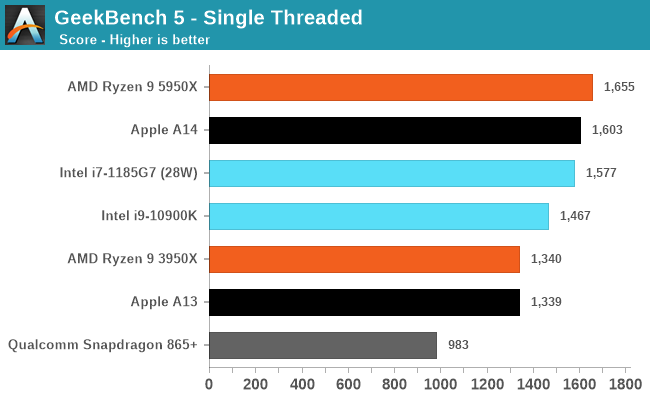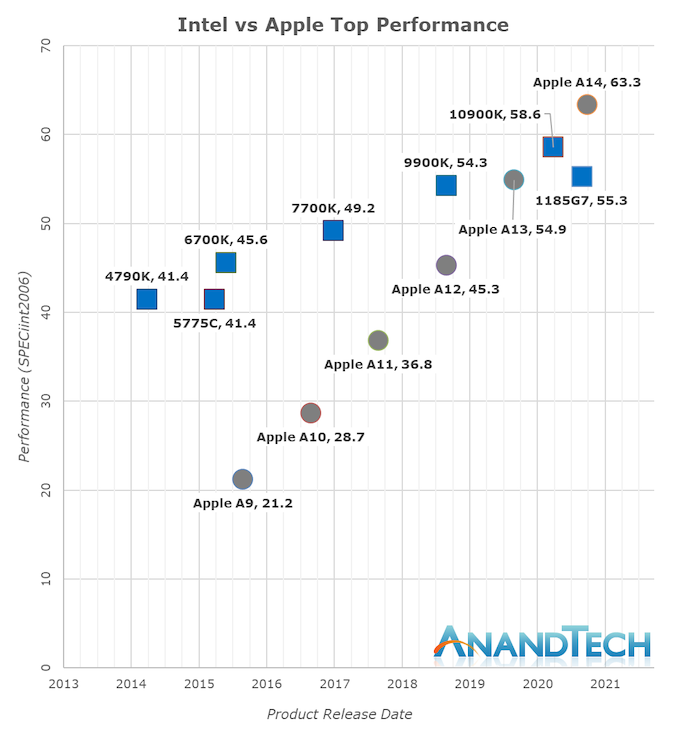Apple Announces The Apple Silicon M1: Ditching x86 - What to Expect, Based on A14
by Andrei Frumusanu on November 10, 2020 3:00 PM EST- Posted in
- Apple
- Apple A14
- Apple Silicon
- Apple M1
From Mobile to Mac: What to Expect?
To date, our performance comparisons for Apple’s chipsets have always been in the context of iPhone reviews, with the juxtaposition to x86 designs being a rather small footnote within the context of the articles. Today’s Apple Silicon launch event completely changes the narrative of what we portray in terms of performance, setting aside the typical apples vs oranges comparisons people usually argument with.
We currently do not have Apple Silicon devices and likely won’t get our hands on them for another few weeks, but we do have the A14, and expect the new Mac chips to be strongly based on the microarchitecture we’re seeing employed in the iPhone designs. Of course, we’re still comparing a phone chip versus a high-end laptop and even a high-end desktop chip, but given the performance numbers, that’s also exactly the point we’re trying to make here, setting the stage as the bare minimum of what Apple could achieve with their new Apple Silicon Mac chips.

The performance numbers of the A14 on this chart is relatively mind-boggling. If I were to release this data with the label of the A14 hidden, one would guess that the data-points came from some other x86 SKU from either AMD or Intel. The fact that the A14 currently competes with the very best top-performance designs that the x86 vendors have on the market today is just an astonishing feat.
Looking into the detailed scores, what again amazes me is the fact that the A14 not only keeps up, but actually beats both these competitors in memory-latency sensitive workloads such as 429.mcf and 471.omnetpp, even though they either have the same memory (i7-1185G7 with LPDDR4X-4266), or desktop-grade memory (5950X with DDR-3200).
Again, disregard the 456.hmmer score advantage of the A14, that’s majorly due to compiler discrepancies, subtract 33% for a more apt comparison figure.

Even in SPECfp which is even more dominated by memory heavy workloads, the A14 not only keeps up, but generally beats the Intel CPU design more often than not. AMD also wouldn’t be looking good if not for the recently released Zen3 design.

In the overall SPEC2006 chart, the A14 is performing absolutely fantastic, taking the lead in absolute performance only falling short of AMD’s recent Ryzen 5000 series.
The fact that Apple is able to achieve this in a total device power consumption of 5W including the SoC, DRAM, and regulators, versus +21W (1185G7) and 49W (5950X) package power figures, without DRAM or regulation, is absolutely mind-blowing.

There’s been a lot of criticism about more common benchmark suites such as GeekBench, but frankly I've found these concerns or arguments to be quite unfounded. The only factual differences between workloads in SPEC and workloads in GB5 is that the latter has less outlier tests which are memory-heavy, meaning it’s more of a CPU benchmark whereas SPEC has more tendency towards CPU+DRAM.
The fact that Apple does well in both workloads is evidence that they have an extremely well-balanced microarchitecture, and that Apple Silicon will be able to scale up to “desktop workloads” in terms of performance without much issue.
Where the Performance Trajectory Finally Intersects
During the release of the A7, people were pretty dismissive of the fact that Apple had called their microarchitecture a desktop-class design. People were also very dismissive of us calling the A11 and A12 reaching near desktop level performance figures a few years back, and today marks an important moment in time for the industry as Apple’s A14 now clearly is able to showcase performance that’s beyond the best that Intel can offer. It’s been a performance trajectory that’s been steadily executing and progressing for years:
Whilst in the past 5 years Intel has managed to increase their best single-thread performance by about 28%, Apple has managed to improve their designs by 198%, or 2.98x (let’s call it 3x) the performance of the Apple A9 of late 2015.
Apple’s performance trajectory and unquestioned execution over these years is what has made Apple Silicon a reality today. Anybody looking at the absurdness of that graph will realise that there simply was no other choice but for Apple to ditch Intel and x86 in favour of their own in-house microarchitecture – staying par for the course would have meant stagnation and worse consumer products.
Today’s announcements only covered Apple’s laptop-class Apple Silicon, whilst we don’t know the details at time of writing as to what Apple will be presenting, Apple’s enormous power efficiency advantage means that the new chip will be able to offer either vastly increased battery life, and/or, vastly increased performance, compared to the current Intel MacBook line-up.
Apple has claimed that they will completely transition their whole consumer line-up to Apple Silicon within two years, which is an indicator that we’ll be seeing a high-TDP many-core design to power a future Mac Pro. If the company is able to continue on their current performance trajectory, it will look extremely impressive.











644 Comments
View All Comments
dotjaz - Wednesday, November 11, 2020 - link
They are probably referring to BootCamp.daveedvdv - Thursday, November 12, 2020 - link
Apple has confirmed that Apple Silicon Macs won't support BootCamp anymore.No, they were definitely talking about Rosetta 2. That said, I don't think they said it was a common occurrence. Just that it had been observed on a real application. At least, that's my recollection.
guycoder - Wednesday, November 11, 2020 - link
I suspect a lot of the graphics privatives are translated to running native and are getting an uplift from the new GPU. Sure this is a fast SOC but Rosetta is also converting large parts of any X86 application to the corresponding Apple ARM system library and taking advantage of the extra hardware on the M1. Still all very impressive so far and it's going to be fun to see what having the CPU / GPU / NPU so tightly integrated will bring.valuearb - Tuesday, November 10, 2020 - link
It's running MacOS, which isn't based on iOS. Actually WatchOS is based on iOS is based on MacOS which is based on NextStepOS.Benchmarks have already shown emulated Intel code is running roughly as fast on Apple Silicon as it runs on Intel Macs. These benchmarks came from Developers using the DTK, the ARM based Mac mini Apple gave developers to develop on earlier this year, and it was running a year old iPad processor.!
And PowerPC wasn't better than Intel, especially at the end.
Luminar - Wednesday, November 11, 2020 - link
PowerPC had the advantage of 3DNow! InstructionsZoolook - Wednesday, November 11, 2020 - link
3DNow! was AMD's answer to MMX, was later dropped (mostly) when they licensed SSE.Zoolook - Wednesday, November 11, 2020 - link
Wish we had an edit function, @Luminar maybe you are thinking about Altivec which was the PowerPC SIMD functions, it was indeed poweerful when it was introduced.Ppietra - Wednesday, November 11, 2020 - link
moving the code shouldn’t take that long for many apps. for many it will only need recompile and debugging.Cubesis - Wednesday, November 11, 2020 - link
Um PowerPC was not better than intel... it was way more power hungry. That’s why they switched to Intel in the first place. Even if moving the code did take a long time, (it won’t) Rosetta 2 improvements combined with them being faster than Intel chips, Means that although I can’t wait for everything to be optimized, I don’t really care when everything performs about the same emulated with Rosetta 2 sometimes even outperforming native intel binaries.Cubesis - Wednesday, November 11, 2020 - link
By the way although I understand where you were going with you were admittedly justified criticisms of Big Sur, your Intel MacBook Pro will be running that same operating system. Unless you plan on letting the system go obsolete with an OS that will be left behind. Fun fact. iOS technologically was derived from MacOS X so to say it’s being done the other way around makes no sense. MacOS can’t be a copy of iOS when iOS is already a copy of MacOS. If your Criticisms are solely about interface changes and methodology then I couldn’t agree with you more and hope it’s at least part of their secret long term plan to incorporate touch into macOS. That would be the only smart reason to make it shittier to navigate using keyboard and mouse LoL